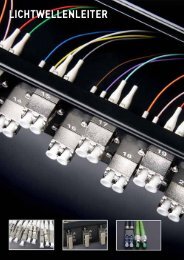Fiber Optics Test Equipment Catalog
Fiber Optics Test Equipment Catalog
Fiber Optics Test Equipment Catalog
Create successful ePaper yourself
Turn your PDF publications into a flip-book with our unique Google optimized e-Paper software.
HOOTS / Laser HOOTS Series<br />
<strong>Fiber</strong> Optic Talk Sets<br />
<strong>Fiber</strong> Optic<br />
<strong>Test</strong> <strong>Equipment</strong><br />
Description<br />
HOOTS stands for High Output Optical Talk Set. HOOTS Series fiber optic talk sets use our light source<br />
technology to convert your voice into optical signals and provide full-duplex communications using a pair of<br />
terminated optical fibers. These talk sets are a reliable alternative to wireless communications systems used<br />
within a premise environment due to their electromagnetic immunity. We designed the HOOTS Series to be<br />
economical in order to be sold as an alternative to walkie-talkies. Optionally, they can be embedded as a<br />
permanent part of a fiber network installation. Use them during the installation for end-to-end voice<br />
communications, then after installation leave them attached to a spare pair of optical fibers inside the fiber patch<br />
panel. This way, the HOOTS can be used by Information Technology (I.T.) personnel for communications<br />
whenever operations or management functions need to be done in the fiber cable closet. There are several<br />
advantages to using a fiber talk set versus walkie talkies. The first advantage is when I.T. personnel are setting<br />
up voice or data optical equipment, they may give away passwords and secret net addresses over un-secure<br />
walkie-talkie channels to a nearby neighborhood of listening ears! The second advantage is that everyone is<br />
buying these cheap walkie-talkies from the local discount stores. It’s getting much more difficult to find free<br />
channels over the air waves. The third advantage is the noise and walls in many plants inhibit radio<br />
transmissions. <strong>Fiber</strong> communications is more secure and most of all, immune to the effects of EMI/RFI. Four<br />
models are available: HOOTS 850 and HOOTS 1300 for communicating over multimode fibers, and Laser<br />
HOOTS 1310 and Laser HOOTS 1550 for singlemode fibers. Each set comes with a pair of headsets and<br />
headset adapters, hard-shell carrying case, protective rubber boots, carrying straps, 9-volt batteries, NISTtraceable<br />
certificate of calibration, and CD-ROM with operations manual.<br />
Specifications<br />
Center Wavelength<br />
850<br />
1300<br />
1310<br />
1550<br />
Spectral Width<br />
850<br />
1300<br />
1310<br />
1550<br />
Output Power<br />
multimode<br />
singlemode<br />
Receiver Dynamic Range<br />
Initial Accuracy<br />
850 +30 / -10 nm<br />
1300 ± 50 nm<br />
1310 ± 20 nm<br />
1550 ± 30 nm<br />
50 nm<br />
180 nm<br />
2 nm<br />
2 nm<br />
-20.0 dBm (LED)<br />
-10.0 dBm (FP laser)<br />
-20 to -40 dBm<br />
± 0.10 dB<br />
Ordering Info<br />
HO-850 HOOTS 850 multimode talk set (850nm; LED; ST connectors)<br />
HO-1300 HOOTS 1300 multimode talk set (1300nm; LED; ST connectors)<br />
LH-1310 Laser HOOTS 1310 singlemode talk set (1310nm; Laser; ST connectors)<br />
LH-1550 Laser HOOTS 1550 singlemode talk set (1550nm; Laser; ST connectors)<br />
Dimensions<br />
To calculate talkset distance:<br />
where:<br />
4.94” x 2.75” x 1.28”<br />
D = R / A<br />
D = talkset distance<br />
R = dynamic range (HOOTS = 20 dB)<br />
A= typical fiber attenuation at specified ë<br />
Example (ë = 1300nm, R = 20 dB, A = 1.0 dB/km):<br />
D = 20 dB / (1.0 dB/km) = 20 km<br />
Questions<br />
Phone: 262-473-0643<br />
14<br />
owl-inc.com









